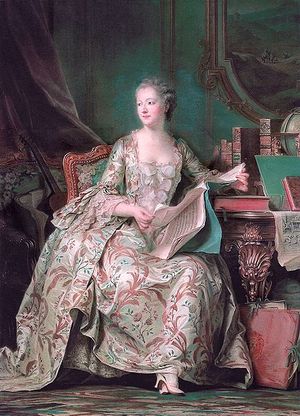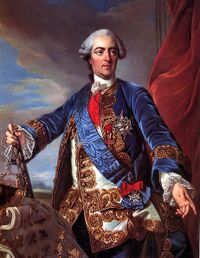Louis Xv
 From Conservapedia
From Conservapedia | Louis XV | |||
|---|---|---|---|
| |||
| Born | February 15, 1710 Palace of Versailles | ||
| Died | May 10, 1774 (aged 64) Palace of Versailles | ||
| Spouse | Marie Leszczyńska | ||
Louis XV (February 15th, 1710 - May 10th, 1774), King of France (1715-1774), was the dominant political figure during the Ancien Régime. His failures in multiple wars and his bad financial policies damaged the power of France, weakened the treasury, discredited the monarchy, and led to the French Revolution which broke out 15 years after his death.
Contents
- 1 Life
- 2 Palace politics
- 3 Foreign policy
- 4 Image and public opinion
- 5 Bibliography
- 5.1 Mistresses
- 5.2 Primary sources
- 5.2.1 notes
Life[edit]
He was the great-grandson of Louis XIV and the son of Louis, Duke of Burgundy, and was born at Versailles on Feb. 15, 1710. He succeeded Louis XIV to the throne at the age of five and during his minority the regency was held by Philip II, Duke of Orléans until his death in 1723. The king was declared of age in 1723 and married Maria Leszczygska, daughter of Stanislas I, King of Poland.
Palace politics[edit]

His first ministry was headed by Louis Henri, Duke of Bourbon, who was displaced by the king's tutor, Cardinal André de Fleury, in 1725, and on the latter's death in 1743, Louis assumed personal control of the government.
In practice the king's several mistresses exercised the dominant influence in selecting or removing his ministers of state. The most famous of Louis' mistresses were Marie Anne de Maillynesle, Duchess of Châteauroux; the Irish woman Louisa O'Murphy (1736-1815, mistress 1752-55);[1] Jeanne Antoinette Poisson, Marquise de Pompadour (called Madame de Pompadour, the mistress from 1745 to her death in 1756); and Marie Jeanne Bécu, Comtesse du Barry.
The Triumvirate arose in 1771, when Louis XV banished the Duc de Choiseul (1719–85), Minister for Foreign Affairs from 1758, and reshuffled the cabinet. René Nicolas de Maupeou (1714–92) was appointed Chancellor of France and Minister of Justice, Joseph Marie Terray (1715–78) became Minister of Finance, and the Duc d' Aiguillon (1720–88), Minister for Foreign Affairs. They fought against the Parlements and had the judiciary run by the Council of State. Louis XVI restored the Parlements and removed the triumvirs from their posts.
Behind the splendor and glitter of 18th century Versailles existed a contentious and dangerous hotbed of royal family politics. Throughout the second half of his reign, Louis XV experienced opposition and intrigue from his children, particularly his son Louis (the dauphin) and his eldest surviving daughter Adélaïde. Fortunately for the king, this intrigue of family politics took place within the environs of Versailles, an environment that was his to control. Louis XV was able to use this palatial space to oversee and counter his children's politics and intrigues. Louis XV communicated his satisfaction and displeasure within the transformations he made at Versailles.[2]
Foreign policy[edit]
During the half-century that he ruled France, Louis obtained possession of Lorraine at the Peace of Vienna (1738), following French intervention in Poland on behalf of Stanislas Leszczygski, the king's father-in-law, who had been ruler of Lorraine since 1735; and in 1768 France also annexed Corsica. For the most part Louis' reign was peaceful until 1740, when France became entangled in the War of the Austrian Succession in alliance with Frederick II, king of Prussia. The war came to an inconclusive end for France in 1748 with the Treaty of Aix-la-Chapelle. During the following period France reversed its alliances, with the result that in 1756 it entered the Seven Years' War on the side of Austria, against Prussia and England. This alliance proved disastrous, for by the humiliating Peace of Paris in 1763 France not only lost her possessions in America (chiefly Canada) and India, but also her position of supremacy in Europe. The defeats led to a reduction in France's international power and prestige. Moreover, French state finances were weak. The king's unpopularity was increased by his succession of mistresses. From 1770, however, the king suddenly began to act with determination. He proposed a reform of, and greater authority for, parliament, reform of law and the justice system, and reform of the French economy. The change in his approach suggested that Louis XV was not weak and vacillating, as many had thought, but rather that he came to royal maturity late and that toward the end of his life he rediscovered the kingly will and authority that his early life and upbringing had stunted.
Image and public opinion[edit]
Edme Bouchardon's equestrian statue of Louis XV was originally conceived to commemorate the monarch's victorious role in the War of the Austrian Succession (1740–48) and artistically executed to display a benign representation of the king as peacemaker. However it was, ironically, unveiled in 1763 following France's defeat in the Seven Years' War. Bouchardon's work designed to be a powerful symbol of loyalty to the king became the centerpiece of a public relations event staged to restore public confidence in a monarchy in decline using art as propaganda on a grand scale.[3]
Louis was unequal to the high expectations of his subjects. Contemporary songs, poems, and public declarations looked for a king who was absolute "master," unblemished "Christian," and benevolent provider ("baker"). Young Louis's failings were attributed to inexperience and manipulation by unscrupulous handlers. As his troubled reign progressed, his debauched private life was revealed and famine repeatedly battered France; the people withdrew their respect, reviled the sycophant king, and ultimately celebrated his demise. The institution of monarchy was intact, but Louis XV saddled his successor with a damaging legacy of popular discontent.[4]
The many sermons on his death in 1774 praised the monarch and went out of its way to excuse his faults. But those ecclesiastics who not only raised their eyebrows over the sins of the Beloved but also expressed doubts about his policies reflected the corporate attitude of the First Estate more accurately. They hoped his successor would restore morals and serve the will of God, which they claimed the role of interpreting.[5]
The financial strain imposed by these wars and by the excesses of the royal court, and the consequent dissatisfaction with the monarchy, contributed to the national unrest which culminated in the French Revolution of 1789. Louis died at Versailles on May 10, 1774.
Bibliography[edit]
- Bernier, Olivier. Louis the Beloved: The Life of Louis XV (1984) 261 pp.
- Engels, Jens Ivo. "Denigrer, Esperer, Assumer La Realite. Le Roi de France perçu par ses Sujets, 1680-1750" ["Disparaging, Hoping, Taking on Reality: the French King as Perceived by His Subjects, 1680-1750"]. Revue D'histoire Moderne et Contemporaine 2003 50(3): 96-126.
- Jones, Colin. The Great Nation: France from Louis XIV to Napoleon, 1715-99 (2002). excerpt and text search
- Justus, Kevin Lane. "A Fractured Mirror: The Royal Portraiture of Louis XV and the Search for a Successful Image through Architecture, or, Versailles Is the Thing in Which We Will Catch the Character of the King." PhD dissertation U. of North Carolina, Chapel Hill 2002. 417 pp. DAI 2003 63(11): 3766-A. DA3070864 Fulltext: ProQuest Dissertations & Theses
- Le Roy Ladurie, Emmanuel. The Ancien Regime: A History of France 1610 - 1774 (1999), survey by leader of the Annales School excerpt and text search
- Perkins, James Breck. France under Louis XV (2 vol 1897) online vol 1; online vol 2
- Woodbridge, John D. "Revolt in Prerevolutionary France: The Prince de Conti's Conspiracy against Louis XV." (1995). 242 pp.
Mistresses[edit]
- Haslip, Joan. Madame du Barry: The Wages of Beauty. (1992). 224 pp.
- Jones, Colin. Madame de Pompadour: Images of a Mistress. London: National Gallery Publ., 2002. 176 pp.
- Lever, Evelyne. Madame de Pompadour. (2002). 320 pp.
- Mitford, Nancy. Madame de Pompadour (1954) 312pp, witty and popular (not scholarly)
Primary sources[edit]
- Du Barry, Jeanne Vaubernier, Jeanne Baecu. Memoirs of the Comtesse Du Barry: With Minute Details of Her Entire Career as Favorite of Louis XV (1903) online edition; also excerpt and text search
notes[edit]
- ↑ She was the daughter of an exiled Irish soldier, who after success as an artist's model became a mistress of King Louis XV from 1752 to 1755. The mother of at least two children fathered by the king, O'Murphy subsequently was married three times (twice to royal officials), became wealthy, and was imprisoned for two years during the French Revolution for her association with the monarchy.
- ↑ Kevin L. Justus, "Gilded Palace, Gilded Playpen: Louis XV's Use of Palatial Space to Control His Rebellious Children and Their Politics." Journal of Family History 1996 21(4): 470-495. Issn: 0363-1990
- ↑ Stephen Rombouts, "Art as Propaganda in Eighteenth-century France: the Paradox of Edme Bouchardon's Louis XV". Eighteenth-century Studies 1993-1994 27(2): 255-282. Issn: 0013-2586 Fulltext: 2.0.CO;2-N">in Jstor
- ↑ Kenneth N. Jassie, "We Don't Have a King: Popular Protest and the Image of the Illegitimate King in the Reign of Louis XV". Consortium on Revolutionary Europe 1750-1850: Proceedings 1994 23: 211-219. Issn: 0093-2574
- ↑ Jeffrey Merrick, "Politics in the Pulpit: Ecclesiastical Discourse on the Death of Louis XV." History of European Ideas 1986 7(2): 149-160. Issn: 0191-6599
Categories: [French Monarchs] [French History] [French Revolution]
↧ Download as ZWI file | Last modified: 02/11/2023 13:54:14 | 68 views
☰ Source: https://www.conservapedia.com/Louis_XV | License: CC BY-SA 3.0
 ZWI signed:
ZWI signed:
 KSF
KSF